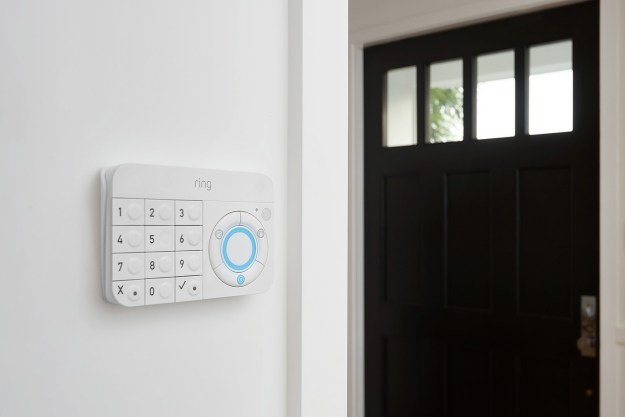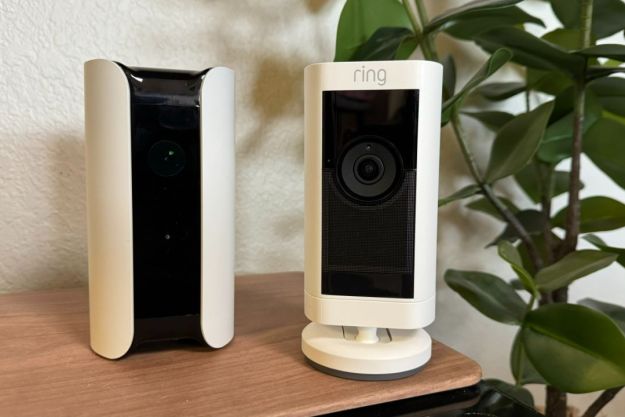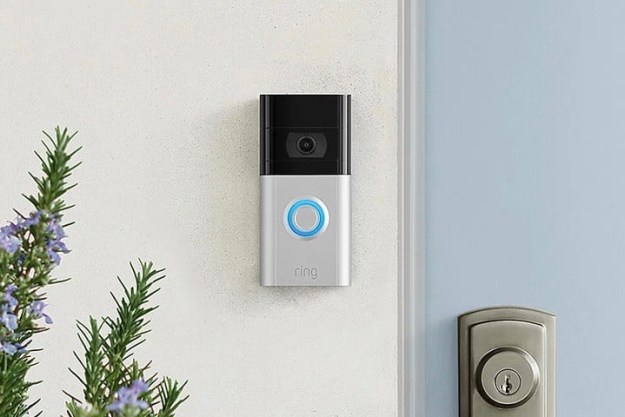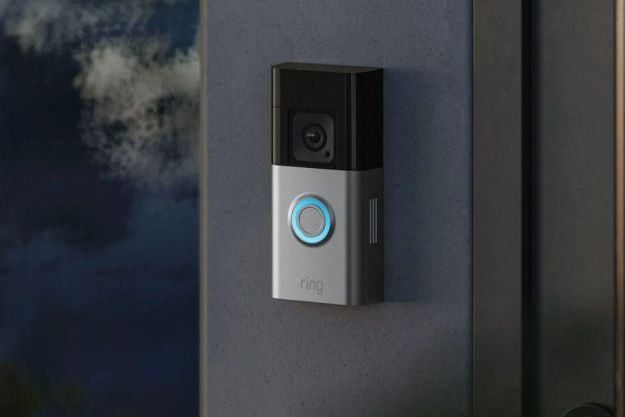
- Affordable
- App and devices work well
- Easy setup
- Quality hardware
- Limited smart home integration – for now
- Professional monitoring costs extra
With Ring’s do-it-yourself home security products — including its iconic original video doorbell — available for some time now, we knew that it would only be a matter of time before the company launched a comprehensive home monitoring system to bring it all together.
Now, despite a few hiccups along the way, that system, called Ring Alarm, is finally available online and in stores. At just $199, it’s one of the cheapest home security systems on the market, but as we found out when we tested it, that doesn’t mean Ring skimped on features.
Hey good lookin’
The Ring Alarm system comes in an attractively packaged box that includes a square base station, a keypad, contact sensor, motion detector, and range extender. Unlike the Nest Secure home monitoring system, Ring created the hub and keypad as separate devices to give homeowners more control over where to place them. The products are both lightweight and durable, although the keypad digits do feel a bit antiquated when you press them.
All the tools you need to mount the keypad on the wall are included, as are complete instructions on how to set up and use the system. The keypad can either attach to a wall (it’s battery operated), or if you don’t feel like putting holes in your wall, you can simply place it on a table.
Download the Ring app (available for both iOS and Android) and connect the Alarm with your existing Ring devices, or, if this is your first Ring product, follow the instructions and advice on how to get started. Both the app and written materials in the box provides helpful suggestions on how and where to set up your motion sensors and contact sensors.
If you already have a Ring video doorbell or security camera, you’ll be happy to know that the system integrates nicely with those products, and all the devices run together under the same app.
Ring provides a top-notch DIY home security system that is well-thought out and responsive.
We set up the base station in our office, the contact sensor on the front door, the keypad on the front table, the motion detector in the hallway, and the range extender in our laundry room. You can add additional motion sensors and contact sensors to the system for additional coverage. We added a couple of sensors to windows on the first floor of our home for added security.
A couple of important things to note during setup. First, for the contact sensor, be sure to have the magnets aligned, otherwise it won’t work. We learned this the hard way after spending an hour troubleshooting. Second — and this is really important – depending on where you live, you may need to get a permit for the system from a local government agency. Ring helps you navigate through this process by looking up your address and telling you whether a permit is required.
In our case, we did need to get a permit for our Ring Alarm system. Ring sent us an email telling us this, and provided us the name of the jurisdiction we needed to contact to obtain the permit (in this case it was our county sheriff’s office). Ring even provided us with a link to the local jurisdiction with more information.
How Ring Alarm works
Once you do get the Ring Alarm set up, you have three options for monitoring.

You can set your system to “Away,” which means that all the sensors connected to the system are monitored for activity. “Home” mode means that all exterior and perimeter sensors are monitored, but not inside your home. “Disarmed” mode means that all monitoring is off, and is useful if you’re having a barbecue and people are coming in and out of the house frequently. You can change modes by hitting the corresponding button on the keypad and the access code you’ve created for the system.
You can set the system to delay the Away mode by as much as you need to get yourself out the door, and you can turn sensor chimes on or off. You can also always arm the system remotely via the app if you forget to do it when you walk out the door. The keypad also features two red panic buttons that will immediately trigger the alarm.
All the tools you need are included, as are complete instructions on how to set up and use the system.
So, where does the professional monitoring come in? When the alarm is triggered, the Ring Alarm central monitoring system calls you and asks for the verbal security code you’ve set up. If Ring doesn’t reach you, they’ll call your emergency contact and ask for the same thing. If either of you forget the code (better choose something you’ll remember!) or if they’re unable to reach either person, then they’ll dispatch emergency responders to your house.
Because it’s a bit unethical to trip a false alarm to test out the system, we’re unable to tell you if this process goes smoothly. But if we ever find ourselves dealing with an alarm, we’ll be sure to update you on how it goes.
Shut the door!
This is something we remind our four-year-old son of often, as he’s prone to leaving doors open because, well, he’s four. That means that the Disarmed mode comes in handy when he’s awake and running in and out of the house. It’s nice to have three options instead of just the typical “armed” or “disarmed” features that don’t take into account movement that is occurring just by living in the house.
When we tested out the accuracy of the motion and contact sensors, we were impressed with how quickly our app registered movement. Opening the door meant that our app automatically showed the “faulted” icon indicating movement – in fact, it was almost instantaneous. Same for the motion detection sensor – the notification on both the hub and the app appeared almost immediately. This was the case whether we were in the house or not. With some devices we’ve tested, particularly with security cameras, there’s often a lapse with notifications. It doesn’t appear to be the case here.
Speaking of the app, it’s easy to navigate and to get a quick snapshot of what’s going on. Sensors that are “faulted” or triggered, are shown in red, while “cleared” sensors are shown in blue. The color coding makes it easy to get a snapshot of what’s going on in your house with just a glance.
Amazon Alexa integration
Ring is owned by Amazon, so at launch we fully expected to be able to have our security system chatting it up with our Amazon Alexa and other smart home devices. But that’s wasn’t the case, at least not initially. Mike Harris, Ring’s President of Ring Solutions, told Digital Trends that Ring wanted to focus on security first and foremost, as well as getting people comfortable with the system, before introducing integration with other products.
“Eventually, we’ll be cozying up with Amazon,” Harris told Digital Trends, noting that integration will include other items associated with security, like door locks and light bulbs. “It’s going to do all of those things and more.”
For $10 a month, you’ll get the service, along with unlimited access to your video recordings.
Amazon recently announced something called “Alexa Guard.” When you set Guard to Away mode,
One final thing to note: You need to pay for the professional monitoring service. For $10 a month, you’ll get the service, along with unlimited access to your video recordings. Unlike some of the old-school hard-wired security systems, though, there’s no contract or cancellation fee.
Warranty information
Ring offers a one-year warranty on all parts, and guarantees tamper-proof devices mounted outside your home. They will replace a video doorbell free of charge if someone manages to steal it.
Our Take
Overall, we were impressed with the responsiveness of the system and the price. At just $199, Ring provides a top-notch DIY home security system that is well-thought out and responsive. As Ring adds more smart home device compatibility, it will be easy to control and monitor many aspects of your home.
Is there a better alternative?
There’s not much that can match Ring’s price point and quality. Nest Secure is an excellent system, but will set you back $399. The Abode Starter Kit is cheaper than Nest at $299, but still lacks the finesse and quality of Ring. Samsung SmartThings and ADT have partnered on a home monitoring system, but it costs $389, and several features are missing to make it an integrated, comprehensive system.
How long will it last?
Ring has established itself as one of the premiere home security companies, and with a one-year warranty and durable, well-made parts, we think this system could last several years. Ring already has plans for adding additional pieces of hardware to the system and is known for regular firmware and software updates. You’re in good hands.
Should you buy it?
If you are looking for an affordable home monitoring system, you can’t go wrong with Ring. Buy it.
Editors' Recommendations
- Blink Mini 2 vs. Ring Stick Up Cam Pro: Which is the best security camera?
- Ring Battery Doorbell Pro vs. Aqara G4: Which is the better video doorbell?
- Best Ring deals: Save on Ring doorbell and Ring alarm bundles
- Blink Mini 2 vs. Blink Mini: Is Amazon’s new security camera a worthy upgrade?
- Does the Ring Stick Up Cam Pro rotate or swivel?








